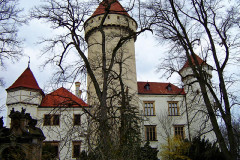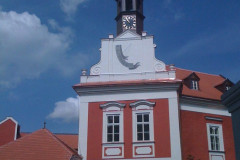Cesky Sternberk Castle
Description
Český Šternberk Castle is a Bohemian castle of the mid-13th century, located within the village with the same name of the Central Bohemian Region in Czech Republic. It is an early Gothic castle which was constructed, named and still owned by members of the same family. Český Šternberk Castle is today a residence that bears a long historical and architectural heritage and represents an attractive tourist destination open to the public. It is considered one of the best preserved Gothic Bohemian castles.
Name
The name Šternberk derives from the German language and is the Czech spelling of the German composite word Sternberg (literally meaning "Starmountain": Stern meaning "star" and Berg meaning "mountain"). It originates from the founder of the castle, Zdeslav of Divisov's coat of arms, bearing an eight-pointed golden star. Eventually he changed his surname to Sternberg and the heraldic symbol was accompanied by the motto: "The star that never falls down".
History
The castle was initially built in 1241 by Zdeslav of Divisov, later called Zdeslav Sternberg. The development of new firearms in the 14th century posed an unexpected threat to the defensibility of the castle. Its 13th century architects hadn't foreseen the danger of long-range firearms and its reinforcement became a necessity. During this period the Český Šternberk castle's fortifications were improved through the construction in the north of a three-story tower, which was connected to the castle by a rampart. In 1467 the castle was seized by the royal armies of George of Poděbrady (Czech: Jiří z Poděbrad). Later, the ruined castle was regained by Šternberk's aristocracy, who, by the turn of the 15th to 16th century, had reconstructed the castle, renewed its defensive system and expanded it with the construction of a new cylindrical tower in the south and the Dungeon in the north. The castle managed to survive the looting of the rebels in 1627, during the Thirty Years' War. With the death of Jan Václav in 1712, the Holicý branch of the Sternberg family died out and its ownership passed to other families, who in 1751 built the lower palace next to the surrounding wall.
The ownership of the castle was returned to the Sternberg family in 1841 when Zdeněk of Sternberg from the Konopiště branch of the family bought it. It remained in Sternberg's ownership until 1949 when it was "nationalized" by the Communist government of the Republic of Czechoslovakia. The family moved to a small flat in Prague and Jiří Sternberk, agreed to work as a steward in his own property and gave tours within the castle, which became a sightseeing spot. After the fall of Communism and the Velvet Revolution, in 1992, thanks to the restitution's law, Český Šternberk castle returned to Jiří's son, the count Zdeněk Sternberg, the current owner of the castle.
Architecture
Český Šternberk Castle was originally built as a Gothic castle Eventually it underwent several periods of reconstructions and further fortification and the Gothic architectural features were in parts concealed by the new reconstructions. Especially the interiors of the castle were realized under the Baroque and Rococo styles. In 1760, the master Carlo Brentano performed the elaborate stuccoing and renderings of the halls' interiors. The castle offers a rare collection of 545 copper engravings, depicting the entire history of the Thirty Years' War. Also, historical weapons and hunting trophies are exhibited within the castle’s halls.
Location
The castle is located within Benešov District in the Central Bohemian Region of the Czech Republic. It stands on top of a steep granite cliff on the western banks of Sázava river in the market town of Český Šternberk, at 50 kilometres (31 mi) driving distance southeast of the capital Prague (45 kilometres (28 mi) as the crow flies) along D1 motorway.
The castle in popular culture
Český Šternberk castle appears in several scenes throughout the Albanian-Czech romantic drama film The Sorrow of Mrs. Schneider (Czech: Smutek paní Snajdrové). The events of the film take place in 1961, in Český Šternberk and the role of the count Jiří Sternberg, the father of today's owner of the castle Zdenek Sternberg, is portrayed by the internationally acclaimed Italian actor Michele Placido.
Count Zdenek Sternberg, happy to meet the Italian actor and after learning that he was interpreting his father in the movie, generously offered free use of the castle’s spaces. Anyway, he couldn’t meet with Michele Placido after falling ill during the filming days. There is a whole considerable scene within Český Šternberk castle, a remarkable dialogue between the movie’s main character and count Sternberg (Placido).
Street view
Reviews
One notable and unusual fact is that the castle is still held by the same family today. The current owner is the 20th generation descendant of the founder.
In 1467 the castle was captured and later renovated in the late Gothic style. Improvements were made especially to the castle defenses, such as a south-facing projecting bastion built en bec (with a sharp beak) called the Dungeon, which today serves as a look-out point.


